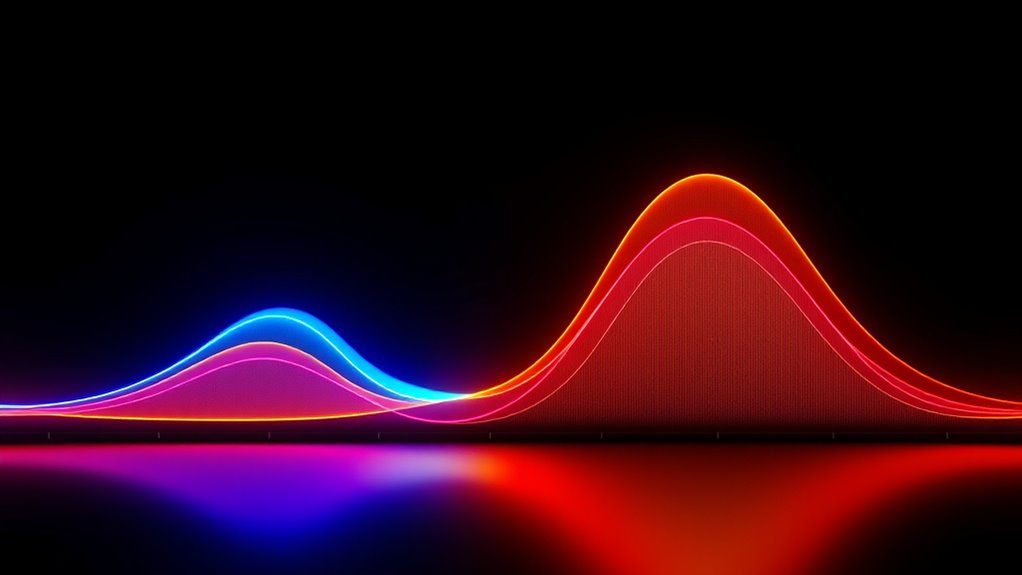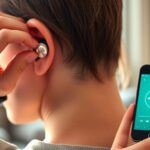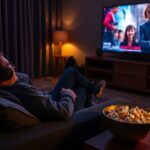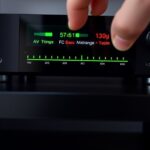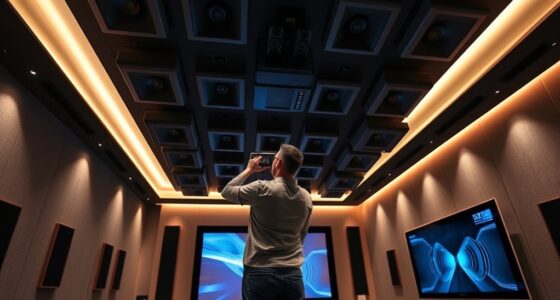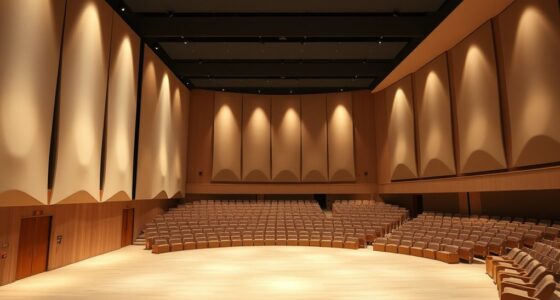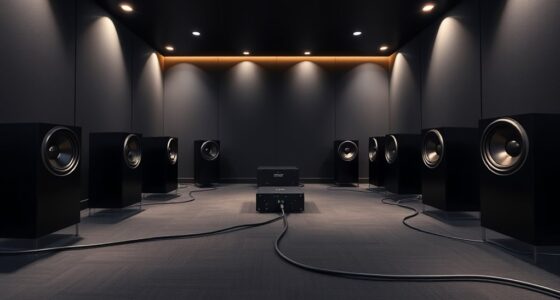The Fletcher-Munson curve shows how your ears perceive loudness differently across frequencies and volumes. It reveals that your hearing is most sensitive to mid-range sounds while bass and treble require higher volumes to be heard clearly. By understanding this, you can adjust speakers, headphones, or sound mixes for a balanced and natural experience. Keep exploring, and you’ll discover how this curve helps create speakers and audio tools that match your hearing.
Key Takeaways
- The Fletcher-Munson curve illustrates how human hearing sensitivity varies across frequencies at different volume levels.
- It shows that mid-range frequencies are perceived as louder at lower volumes, guiding sound calibration.
- Understanding the curve helps audio engineers tailor sound equalization for natural and balanced listening experiences.
- It highlights the importance of adjusting audio levels to compensate for hearing sensitivity variations.
- The curve informs the design of audio equipment to optimize sound clarity across different loudness settings.
Understanding the Origins of the Fletcher-Munson Curve

To understand the origins of the Fletcher-Munson Curve, it helps to recognize that human hearing is inherently non-linear. Your ears perceive different frequencies with varying sensitivity, which can lead to auditory illusions—where sounds seem different from their actual source or intensity. This non-linear perception influences how you interpret musical timbre, the unique quality of each sound. This is why sound perception varies among individuals, making personalized sound calibration important for optimal listening experiences. Early studies found that your ear is most sensitive to mid-range frequencies, while bass and treble sounds require higher volumes to be heard clearly. These findings shaped the creation of the Fletcher-Munson Curve, revealing how your hearing responds across volume levels. Additionally, auditory perception varies among individuals, making personalized sound calibration important for optimal listening experiences. Understanding the frequency response of human hearing allows sound engineers to tailor audio for different environments and listeners, enhancing the overall listening experience. Recognizing the importance of loudness perception helps in designing audio systems that deliver accurate sound reproduction for diverse audiences. By understanding this, you can better appreciate why equal loudness adjustments are necessary for accurate sound reproduction, ensuring your listening experience aligns with your natural hearing sensitivities. Moreover, research shows that hearing thresholds can change with age and exposure to loud sounds, further emphasizing the need for personalized audio settings.
How Human Hearing Sensitivity Varies With Volume

When you listen at different volumes, your ears respond differently to various frequencies, affecting how you perceive loudness. This phenomenon is related to the Fletcher-Munson curve, which illustrates how human hearing sensitivity varies with volume. As volume changes, your sensory response shifts, making certain sounds seem more or less prominent. This means that perceived loudness isn’t fixed but varies depending on how loudly you’re listening. Understanding auditory perception helps explain why sound quality can feel different at various volume levels. Additionally, the sensitivity of human hearing changes dynamically across the frequency spectrum, emphasizing the importance of tailored sound adjustments.
Sensory Response Changes
Human hearing sensitivity doesn’t remain constant across different volume levels; instead, it changes depending on how loud the sound is. When sounds are softer, your ears rely heavily on auditory illusions to interpret signals, making subtle cues harder to detect. As volume increases, your ability to localize sound improves, but sensitivity shifts, affecting perception. These changes influence how you experience sound, especially in complex environments.
Consider these emotional impacts:
- Feeling lost in a crowded room due to poor sound localization.
- Missing essential cues in music or speech at lower volumes.
- Experiencing distorted perceptions during loud concerts.
- Struggling to distinguish nuances when volume fluctuates.
Understanding this variability helps you better grasp how your ears adapt, shaping your overall auditory experience.
Volume-Dependent Frequencies
As your ears adjust to different sound levels, their sensitivity to various frequencies shifts considerably. At lower volumes, your hearing is more sensitive to mid and high frequencies, making sounds seem sharper and more distinct. As volume increases, the sensitivity to bass frequencies improves, while some high frequencies may become less prominent due to frequency masking. This masking effect occurs when louder sounds drown out nearby frequencies, affecting sound clarity and perception. Additionally, volume changes influence sound localization, altering how you perceive the direction of sounds. When listening at different levels, your brain relies on these frequency sensitivities to interpret spatial cues and clarify sounds. Recognizing the importance of digital literacy helps you understand how to tailor audio to match human hearing sensitivity, ensuring a more accurate and balanced listening experience. Being aware of credit card security measures also sheds light on how digital payment systems protect your financial information during sound processing or online transactions. Moreover, understanding how audio calibration adjusts sound systems can help optimize hearing across different volume settings for a more consistent auditory experience. Furthermore, knowledge of Fletcher-Munson curves allows audio engineers and listeners to better understand how perceived loudness varies with frequency and volume, enabling more precise sound adjustments. An awareness of frequency masking is crucial for appreciating how certain sounds can influence the perception of others at varying volume levels.
Perceived Loudness Variations
Your ears don’t perceive loudness uniformly across different sound levels; instead, their sensitivity to various frequencies changes as volume increases or decreases. This variation influences how you experience auditory illusions and sound localization. As volume drops, your hearing becomes less sensitive to high frequencies, making sounds seem muffled or distant. Conversely, increasing volume can make subtle cues clearer, sharpening your perception. You might notice that at lower volumes, certain sounds seem to shift or blend, affecting your ability to pinpoint their origin. These perceived loudness variations impact your overall listening experience and highlight how human hearing adapts dynamically. Recognizing this helps in designing audio that feels natural and balanced, regardless of volume.
- You might miss subtle cues at low volumes.
- Auditory illusions become more convincing.
- Sound localization shifts with volume changes.
- Your hearing adapts to ensure clarity.
The Role of Equal Loudness Contours in Audio Engineering
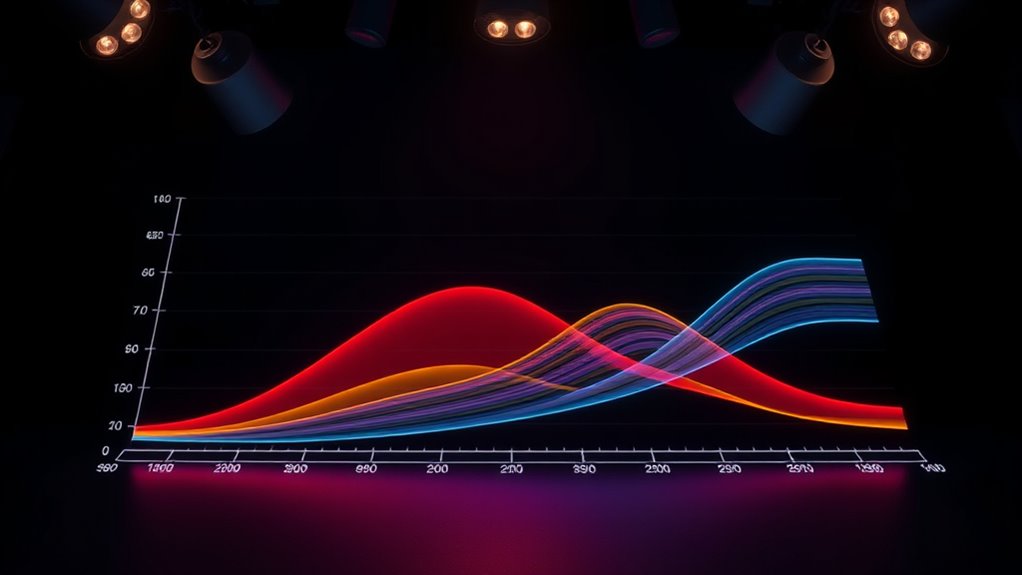
Equal loudness contours, represented by the Fletcher-Munson curves, play a crucial role in audio engineering by revealing how your ears perceive different frequencies at various loudness levels. Understanding these contours helps you optimize sound to stand out amid environmental noise or for effective sound masking, where certain frequencies are emphasized or suppressed. When designing audio systems, you can tailor equalization to compensate for perceived sensitivity shifts, ensuring clarity whether in quiet settings or noisy environments. Recognizing how perceived loudness varies across frequencies allows you to create balanced mixes that maintain clarity and impact. These contours also provide insight into human hearing sensitivity, guiding you in shaping sound that aligns with human hearing, which is further supported by advancements in AI in Business that enhance audio processing technologies. Improving listening experiences in diverse acoustic conditions is achievable by applying knowledge of equal loudness contours, especially when considering sound perception variability across different listeners. Additionally, understanding the perception of loudness at different levels helps in designing audio that is both effective and comfortable for a wide range of listeners. Moreover, integrating auditory perception models into audio design can further refine how sound is tailored to match human hearing characteristics.
Interpreting the Shape of the Fletcher-Munson Curve
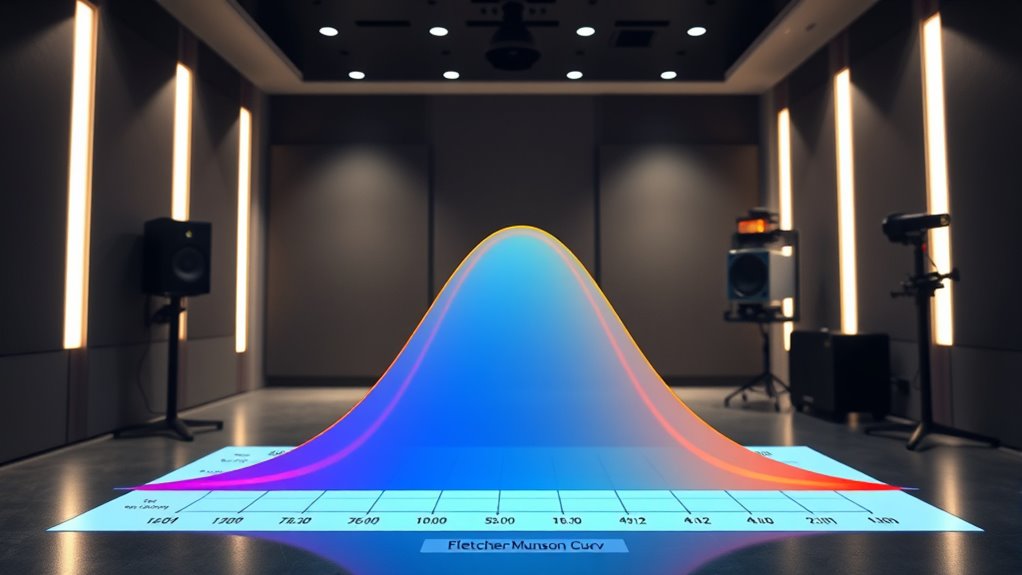
The shape of the Fletcher-Munson curve reveals how the human ear perceives loudness across different frequencies at various sound levels. You’ll notice prominent frequency peaks around 2-5 kHz, where our hearing is most sensitive, even at low volumes. The curve’s asymmetry shows that at higher volumes, our ears perceive bass and treble differently; bass feels more prominent, while treble can seem less intense. Understanding this shape helps you recognize that loudness perception isn’t uniform across frequencies. By analyzing these features, you can improve sound quality and balance. Key insights include:
The Fletcher-Munson curve shows how our hearing perceives loudness differently across frequencies and volumes.
- Recognizing the importance of frequency peaks for clarity
- Noticing how curve asymmetry influences perceived bass and treble
- Understanding that sensitivity varies with volume
- Applying this knowledge to create balanced sound experiences
Practical Applications in Sound Design and Mixing

You can use equalization techniques to compensate for human hearing sensitivities across different frequencies, ensuring your mix sounds balanced on various playback systems. Monitoring your audio carefully helps you perceive how loudness and frequency response affect listeners’ perception. Eye patches are an example of how targeted interventions can improve specific conditions, and understanding such principles can inform approaches to sound correction and enhancement. Recognizing how human hearing sensitivities vary across frequencies allows sound engineers to tailor their mixes more effectively. Additionally, awareness of divorce statistics underscores the importance of precise and effective legal guidance in navigating complex situations. Incorporating data analytics into your sound design process can help identify how different frequencies are perceived by various audiences. This understanding aligns with perceptual audio modeling, which emphasizes designing audio solutions that accommodate human auditory perception for optimal clarity.
Equalization Techniques Tailored
Understanding how to tailor equalization techniques is essential for achieving balanced and natural sound in both music production and live sound reinforcement. By adjusting your equalizer, you can compensate for variations in frequency response and hearing thresholds, ensuring clarity across all audio ranges. This approach helps you create a sound that feels authentic and engaging.
Consider these key points:
- Identify problematic frequencies that may be dull or harsh, then apply targeted EQ adjustments.
- Account for hearing thresholds that vary among listeners, customizing the mix for ideal perception.
- Use subtle boosts and cuts to preserve natural balance without overcompensating.
- Refine your settings through critical listening, ensuring your sound remains true to human auditory perception.
Tailoring EQ makes your sound more vibrant, immersive, and true to how humans perceive it.
Monitoring for Perception
Monitoring for perception is crucial in sound design and mixing because it guarantees that what you hear accurately reflects how listeners will perceive the final product. To achieve this, you must be aware of auditory illusions that can trick your ears, such as phantom sounds or perceived depth changes. These illusions influence how sound localization occurs, affecting spatial awareness and the perceived position of instruments. By understanding these phenomena, you can make precise adjustments, ensuring your mix translates well across different listening environments. Regularly test your mix on various speakers and headphones to identify perceptual discrepancies. This approach helps you create a balanced, immersive sound that aligns with human hearing sensitivities and perceptual quirks, ultimately delivering a more engaging listening experience.
Differences Between Equal Loudness and Flat Frequency Response
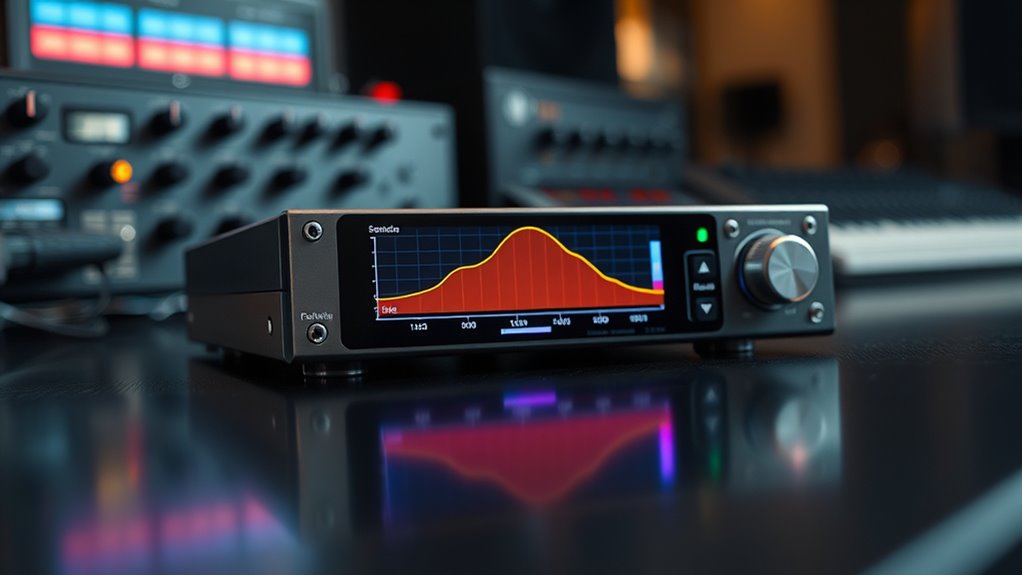
While a flat frequency response aims to reproduce all sounds at the same level, equal loudness curves reveal that your ears perceive different sound frequencies as louder or softer depending on volume. This difference impacts how you experience loudness perception across the spectrum. Understanding this distinction can evoke a sense of control over your listening environment. Consider these points:
- Your perception of bass or treble shifts with volume, not just the sound itself.
- Equal loudness curves show that certain frequencies need more or less amplification to sound equally loud.
- Sound frequency response varies based on loudness perception, influencing how you hear music or speech.
- Tailoring your audio setup to these curves enhances clarity, ensuring a more natural and balanced listening experience.
The Impact of the Curve on Headphone and Speaker Calibration

Your perception of sound varies with volume, so calibrating headphones and speakers requires more than just setting a flat frequency response. The Fletcher-Munson curve shows that our ears perceive bass and treble differently at various volumes, impacting accurate sound reproduction. This understanding influences calibration for sound therapy and auditory training, ensuring sounds are delivered as intended. By adjusting for the loudness curve, you can optimize audio playback to match human hearing sensitivities, making therapy sessions more effective and training more precise. Manufacturers now incorporate this knowledge into calibration tools, helping you avoid skewed sound perception. Proper calibration aligned with the Fletcher-Munson curve ensures your audio experience is true to the source, enhancing both enjoyment and functional applications like sound therapy or auditory training.
Psychoacoustic Principles Behind Loudness Perception
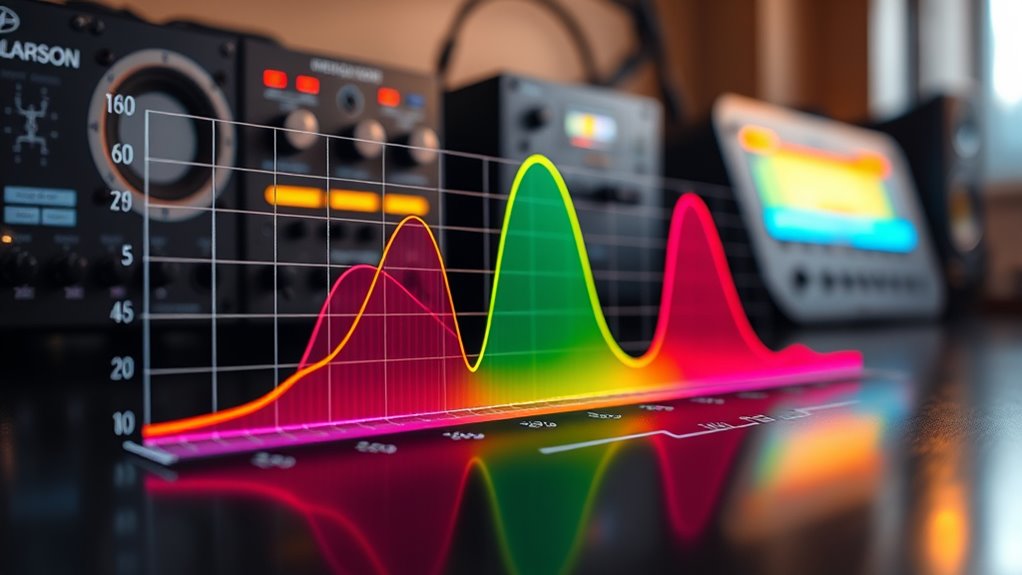
Psychoacoustic principles explain how our brain interprets sound, shaping our perception of loudness beyond mere sound pressure levels. Your perception isn’t solely about volume; it’s influenced by factors like auditory illusions and sound localization. These phenomena reveal how your mind fills in gaps or emphasizes certain sounds, making some tones seem louder or more prominent.
Consider these key insights:
- Auditory illusions trick your brain into perceiving sounds differently, affecting loudness perception.
- Sound localization helps you determine the origin of a sound, influencing how loud it appears.
- Our auditory system prioritizes certain frequencies, altering perceived volume.
- The brain’s interpretation of complex sounds can enhance or diminish loudness, depending on context.
These principles explain why loudness isn’t just about decibels but also how your brain processes sound cues.
Enhancing Audio Clarity Through Equalization Techniques
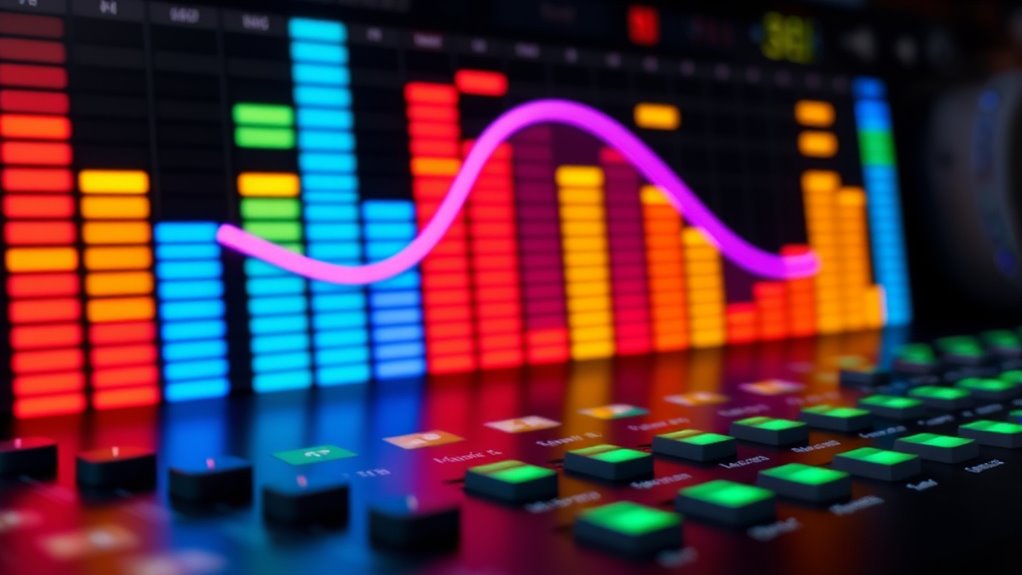
Understanding how your brain perceives sound sets the stage for improving audio clarity through equalization. By recognizing your hearing thresholds, you can target specific frequencies that might be muffled or overly harsh. Equalization allows you to boost or cut these areas, making sounds clearer and more natural. Be mindful of auditory illusions—perceptual tricks that can distort your perception—so you don’t overcorrect and introduce unwanted artifacts. Carefully tailored EQ settings help emphasize speech intelligibility, reduce background noise, and enhance overall listening comfort. Remember, subtle adjustments often produce the best results. Using equalization effectively means aligning your audio profile with how your brain perceives sound, ensuring a more precise and immersive listening experience tailored to your hearing preferences.
Future Directions in Psychoacoustic Research and Sound Personalization
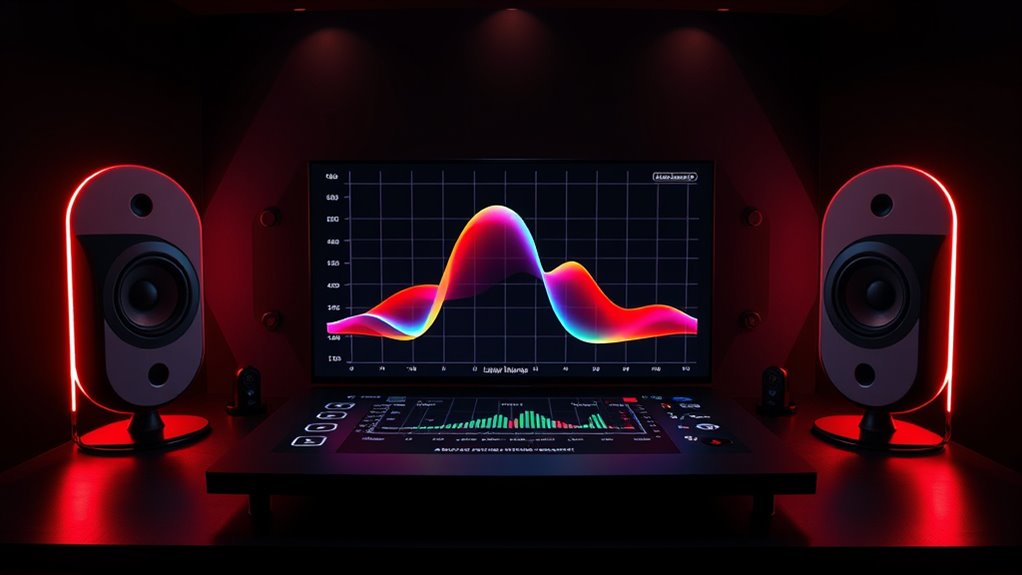
Future research will focus on creating personalized hearing profiles that adapt to your unique auditory needs. You’ll see more advanced technologies that adjust sound in real-time based on neural feedback. These developments could revolutionize how you experience sound and improve clarity across various environments.
Personalized Hearing Profiles
As technology advances, personalized hearing profiles are becoming increasingly feasible, allowing sound systems to tailor audio experiences uniquely for each individual. You could soon experience sound that adjusts to your auditory illusions and enhances sound localization, creating a more immersive environment. Imagine hearing music or dialogue with pinpoint accuracy, making you feel part of the scene. Personalized profiles can identify your specific hearing sensitivities and preferences, optimizing clarity and comfort.
Consider these future possibilities:
- Custom audio adjustments that reduce fatigue and protect your hearing.
- Precise sound localization to improve spatial awareness.
- Adaptive tuning based on your daily activities and environments.
- Enhanced perception of auditory illusions, making experiences more vivid and lifelike.
Adaptive Audio Technologies
Adaptive audio technologies are poised to revolutionize personalized sound experiences by dynamically adjusting to your auditory environment and individual hearing profile. These innovations leverage real-time data to optimize sound delivery, enhancing clarity and immersion. By understanding auditory illusions, these systems can manipulate sound cues to create more natural or immersive experiences, even in noisy settings. They also improve sound localization, ensuring you perceive directionality accurately, which is vital for virtual reality, gaming, and hearing aids. As these technologies evolve, they’ll tailor audio outputs based on your environment, hearing sensitivities, and preferences. This personalization minimizes listening fatigue and maximizes clarity. Ultimately, adaptive audio will make your listening experience more intuitive, immersive, and aligned with your unique auditory perception, pushing psychoacoustic research into exciting new frontiers.
Neural Auditory Mapping
Neural auditory mapping is rapidly advancing, promising to revolutionize how we comprehend and personalize sound experiences. By harnessing neural auditory techniques and sensory mapping, researchers can decode how your brain processes sound uniquely. Imagine a future where your hearing profile is precisely mapped, allowing tailored soundscapes that evoke deep emotional responses. This innovation could:
- Enhance personalized hearing aids for crystal-clear clarity.
- Create immersive audio experiences tailored to your neural responses.
- Detect early signs of auditory disorders with unprecedented accuracy.
- Enable sound environments that resonate emotionally, improving well-being.
Frequently Asked Questions
How Does Age Affect the Fletcher-Munson Curve?
As you age, age-related hearing loss shifts your loudness perception, affecting the Fletcher-Munson curve. You might notice that high frequencies become less sensitive, changing how you perceive loudness at different frequencies. This age-dependent loudness means your hearing profile alters over time, making it essential to adjust sound settings or listening environments to match your current hearing abilities, ensuring clearer, more accurate audio experiences.
Can Individual Hearing Differences Alter the Curve’s Shape?
Personal hearing variability can markedly shape your sound experience. When you consider audiometric customization, you realize each person’s hearing profile differs, influencing how sounds are perceived. These differences can alter the curve’s shape, meaning standard equal-loudness contours might not fit everyone perfectly. By understanding your unique hearing nuances, you can optimize audio output, ensuring sound is tailored precisely to your ears, enhancing clarity, comfort, and overall auditory enjoyment.
How Do Hearing Impairments Influence Loudness Perception?
Hearing impairments affect how you perceive loudness, often making sounds seem muffled or distorted. Hearing aids use audiogram analysis to customize amplification, helping you hear more accurately. These devices compensate for specific hearing loss patterns, aligning sound perception closer to normal. By tailoring sound to your unique hearing profile, hearing aids improve loudness perception, ensuring you experience clearer, more balanced audio in various environments.
What Role Does Headphone Quality Play in Perceived Loudness?
You notice that headphone quality impacts perceived loudness through headphone frequency response and audio fidelity. When your headphones deliver a wide, accurate frequency response, sounds feel more natural and balanced, reducing the need to turn up the volume. Conversely, poor audio fidelity and limited frequency response make audio seem dull or muffled, prompting you to increase loudness. High-quality headphones provide clearer, more precise sound, enhancing your listening experience without excessive volume.
Are There Digital Tools to Visualize Personalized Fletcher-Munson Curves?
You can find digital tools for audio calibration and sound customization that visualize personalized Fletcher-Munson curves. These tools analyze your hearing sensitivity at different frequencies, creating a tailored curve to optimize sound. By using calibration apps or software, you actively customize your audio experience, ensuring balanced loudness and clarity. These visualizations help you understand how your ears perceive sound, leading to a more personalized and comfortable listening experience.
Conclusion
By understanding the Fletcher-Munson curve, you discover the secret to mastering sound like a true audio wizard. Recognizing how your ears perceive loudness at different volumes allows you to craft audio that’s crystal clear and perfectly balanced, no matter the device. This knowledge transforms your listening experience from ordinary to mind-blowingly immersive—like hearing music for the first time all over again. Embrace these psychoacoustic principles and elevate your sound game to legendary heights!
